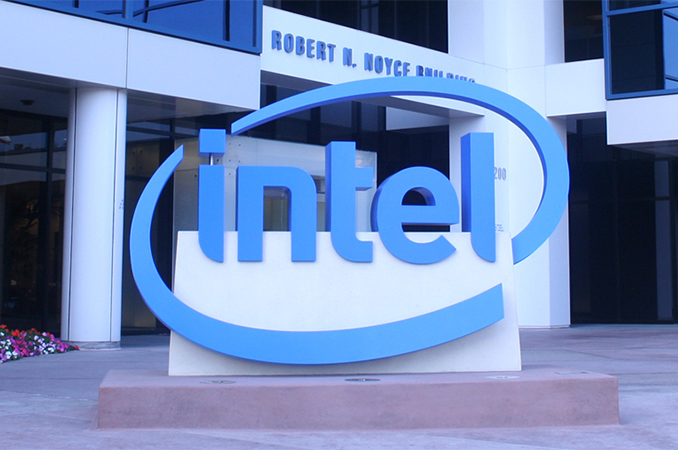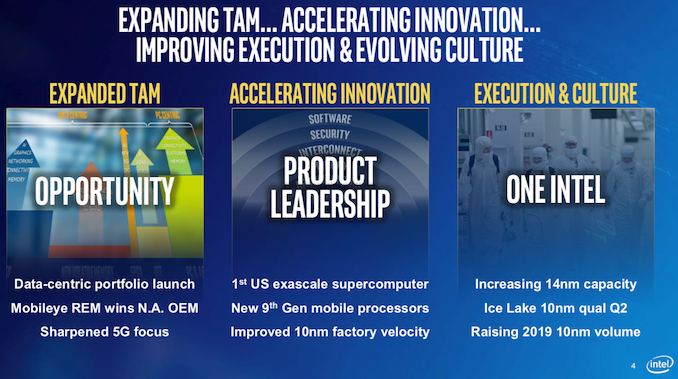Intel Starts Qualification of Ice Lake CPUs, Raises 10nm Volume Expectation for 2019
by Anton Shilov on April 25, 2019 5:14 PM EST
During its Q1 earnings call, Intel provided an update regarding its 10 nm process technology as well as the ramp up of its Ice Lake-U processor for notebooks, which is the company’s first 10 nm design that will be mass produced and broadly available. Qualification for the new processors has already started, so systems based on Ice Lake-U will be available by the holidays, as promised. Furthermore, Intel believes that it will be able to ship more 10 nm parts than it originally anticipated.
Ice Lake-U in 2019
Intel started production of its Ice Lake-U processors in Q1, but Intel has been building up a stockpile of them first before they are sent to PC makers for qualification. Once the CPUs are qualified — something that Intel expects to happen in Q2 — the manufacturer can start sales/shipments of these CPUs, which will likely happen in Q3. Considering the lead-time required to get built systems on to store shelves, Ice Lake-U-based PCs are on track to hit the market in Q4 (something Intel reaffirmed today).
Intel’s Ice Lake-U is a quad-core processor based on the codenamed Sunny Cove microarchitecture. Among other notable features, on the CPU side of matters Ice Lake-U supports VNNI and Cryptographic ISA instructions, as well as Intel's long, long awaited support for LPDDR4X memory. Meanwhile on the GPU side of matters, this is the first chip to integrate Intel’s Gen11 iGPU, which with up to 64 execution units, promises a big step up in performance. The CPU will be paired with a chipset natively supporting Thunderbolt 3, 802.11ax Wi-Fi, and a number of other innovations. The whole Ice Lake-U package is expected to have a TDP of 15 W, so the product will be able to address thin-and-light and mainstream laptops.
10 nm Volume Goals Increased
It is noteworthy that Intel now expects to ship more processors made using its 10 nm process technology than originally anticipated this year as it can produce more these CPUs.
“On the [10 nm] process technology front, our teams executed well in Q1 and our velocity is increasing,” said Bob Swan, CEO of Intel. “We remain on track to have volume client systems on shelves for the holiday selling season. And over the past four months, the organization drove a nearly 2X improvement in the rate at which 10nm products move through our factories.”
Ice-Lake-SP Xeons in 2020
As for 10 nm ramp in general, Intel is only talking about producing its relatively small Ice Lake-U processors in volumes this year, which is the company’s typical way of ramping up a new node. When it comes to their larger Ice Lake-SP server parts, Intel expects to launch those 10 nm Xeon products in 2020. The company says that its Ice Lake-SP CPUs will be available in less than 12 months after its Ice Lake-U products hit the market. In fact, Intel has even advised investors to expect 10 nm Xeons to arrive “rather sooner than later” in 2020, which would imply something earlier than Q4'2020.
Related Reading:
- CES 2019 Quick Bytes: Consumer 10nm is Coming with Intel’s Ice Lake
- Intel 10nm Production Update: Systems on Shelves For Holiday 2019
- Intel Delays Mass Production of 10nm CPUs to 2019
- Intel’s Xeon Scalable Roadmap Leaks: Cooper Lake-SP, Ice Lake-SP Due in 2020
- First 10nm Cannon Lake Laptop Spotted Online: Lenovo Ideapad 330 for $449
- Intel Discloses Plans to Spend $5 Billion on Fab 28 Expansion in Israel
- Intel's 10nm Briefly Appears: Dual Core Cannon Lake in Official Documents
- Intel Mentions 10nm, Briefly
- Intel Displays 10nm Wafer, Commits to 10nm ‘Falcon Mesa’ FPGAs
- Intel: EUV-Enabled 7nm Process Tech is on Track
Source: Intel











70 Comments
View All Comments
KateH - Thursday, April 25, 2019 - link
yeah that used to be the case, afaik Broadwell was the first arch to change that with Intel's pivot to aggressively focusing on their extremely low-power (-Y and - U Core) and extremely high-power (Xeon) partsHStewart - Thursday, May 2, 2019 - link
You ever thought with new design in IceLake, that U Core provides the power of today higher watt CPU and even desktops and that 45watt notebooks are part of past.ksec - Friday, April 26, 2019 - link
Increasing your Throughput by 2x when your initial value is 1 and your original target in Pre 2015 were 10 meant nothing. It will still be a 5x differenceSo as usual with the recent Intel, their 10nm words can not be trusted.
Spunjji - Friday, April 26, 2019 - link
This is exactly what I thought when I read the statement: what's the baseline, and what's the target? 2x fuck-all is still fuck-all, and the way he phrased it implies that it's not even 2x.Santoval - Friday, April 26, 2019 - link
What about PCIe 4.0? If Intel do not upgrade the PCIe controllers of their Sunny Cove / Ice Lake generation they might be stuck with PCIe 3.0 at least until late 2021 - early 2022. Willow Cove (Tiger Lake) is going to be an optimization of the same design, thus PCIe 4.0 might need to wait for Golden Cove (currently Alder Lake) if it is not added to Sunny Cove. I find that highly unlikely, however it is suspect that Intel have not talked about the PCIe generation and lanes of Ice Lake. Unless they have and I missed it.YoloPascual - Sunday, April 28, 2019 - link
I still remember that day when intel told us that we will have 10nm cpus by 2015..ajp_anton - Tuesday, April 30, 2019 - link
"Intel believes that it will be able to ship more 10 nm parts than it originally anticipated."So how many did they originally plan to ship 10nm parts in 2016?
watzupken - Wednesday, May 1, 2019 - link
With this news, I sense rumors that we will not see a 10nm desktop consumer chip till late 2021 till 2022 may be true. The fact that they are focusing on the ULV series in 2019 means the fab is still not ready to take on bigger chips. Even if they are ready for bigger chips, the yield is likely still significantly below their expectation. Intel's move to release Xeons on 10nm first is likely to try to fend their turf from AMD with their Rome chips.Freeb!rd - Saturday, May 4, 2019 - link
"Furthermore, Intel believes that it will be able to ship more 10 nm parts than it originally anticipated." We already seen Intel play this game... they shipped 10nm CannonLake previously... Sure if they thought they could only ship 10K part in 2019 and now they can ship 50K that is a lot more, but not significant for the market.Big details lacking in IceLake-SP Xeon is how many cores will it have and how different from the IceLake-U will it be? Will it just be a low power, slow speed part?
Rash1 - Tuesday, May 7, 2019 - link
Intel might have raised 10nm processors volume because it can produce more but do computer manufacturers and customers benefit from performance improvement and better price over previous Gen processors ? If not than higher volume does not translates into higher adoptions/sale.10nm processors has to offer more like better performance at lower power consumption increasing battery life. More integration on SOC of peripheral components to decrease overall cost.